| کد مقاله | کد نشریه | سال انتشار | مقاله انگلیسی | نسخه تمام متن |
|---|---|---|---|---|
| 6286521 | 1615385 | 2015 | 16 صفحه PDF | دانلود رایگان |
- Gaucher disease is linked to the development of Parkinson's disease.
- GBA1 mutations are the most common risk factor for α-synuclein aggregation disorders.
- Glucocerebrosidase can affect α-synuclein proteostasis through various mechanisms.
- α-Synuclein accumulation decreases glucocerebrosidase, leading to a vicious cycle.
- Increasing glucocerebrosidase activity is a therapeutic approach for synucleinopathies.
Gaucher disease, the most common lysosomal storage disease, is caused by a recessively inherited deficiency in glucocerebrosidase and subsequent accumulation of toxic lipid substrates. Heterozygous mutations in the lysosomal glucocerebrosidase gene (GBA1) have recently been recognized as the highest genetic risk factor for the development of α-synuclein aggregation disorders (“synucleinopathies”), including Parkinson's disease (PD) and dementia with Lewy bodies (DLB). Despite the wealth of experimental, clinical and genetic evidence that supports the association between mutant genotypes and synucleinopathy risk, the precise mechanisms by which GBA1 mutations lead to PD and DLB remain unclear. Decreased glucocerebrosidase activity has been demonstrated to promote α-synuclein misprocessing. Furthermore, aberrant α-synuclein species have been reported to downregulate glucocerebrosidase activity, which further contributes to disease progression. In this review, we summarize the recent findings that highlight the complexity of this pathogenetic link and how several pathways that connect glucocerebrosidase insufficiency with α-synuclein misprocessing have emerged as potential therapeutic targets. From a translational perspective, we discuss how various therapeutic approaches to lysosomal dysfunction have been explored for the treatment of GBA1-related synucleinopathies, and potentially, for non-GBA1-associated neurodegenerative diseases. In summary, the link between GBA1 and synucleinopathies has become the paradigm of how the study of a rare lysosomal disease can transform the understanding of the etiopathology, and hopefully the treatment, of a more prevalent and multifactorial disorder.
Journal: Progress in Neurobiology - Volume 125, February 2015, Pages 47-62
